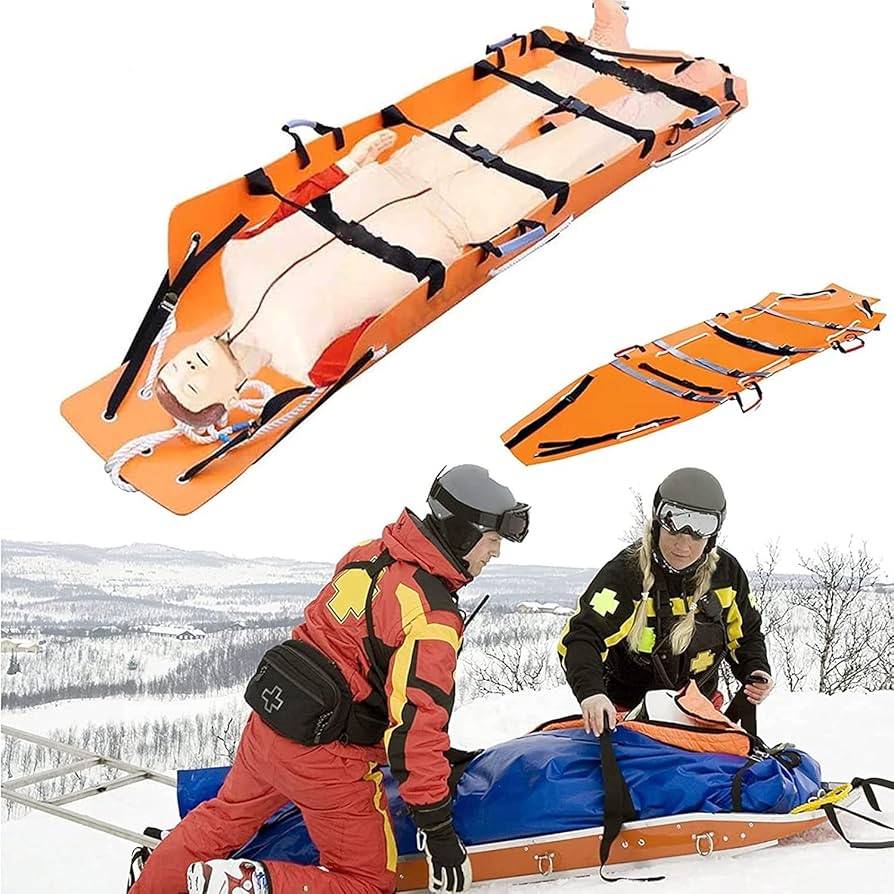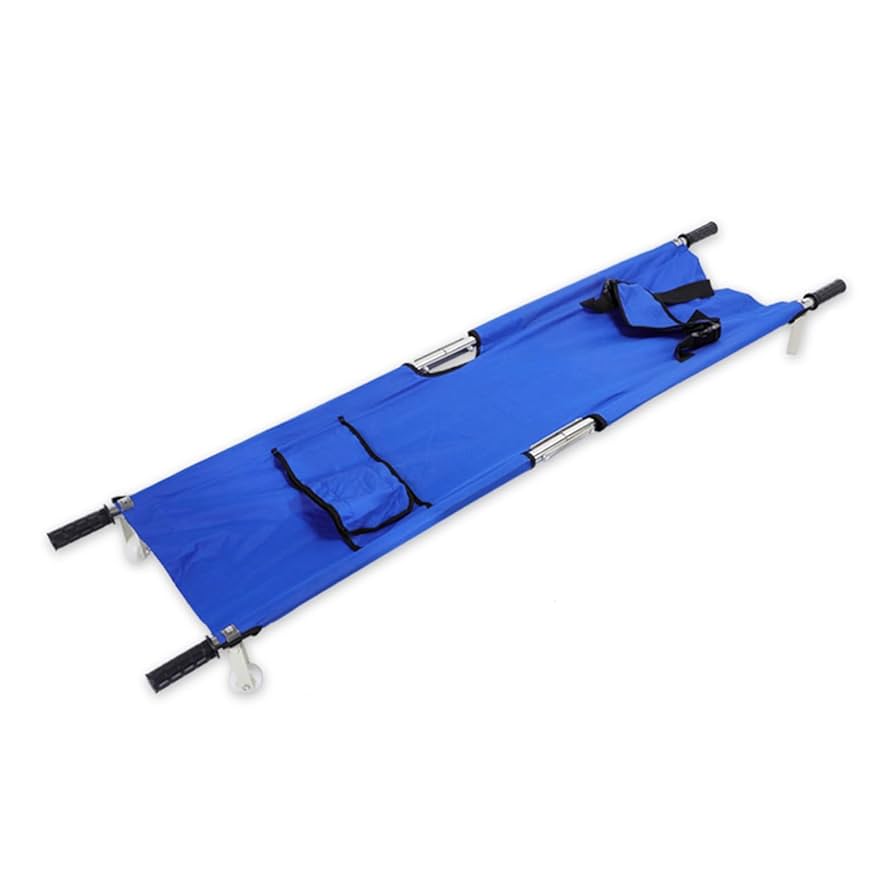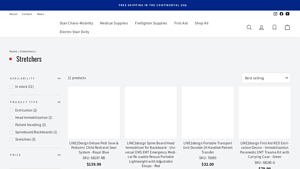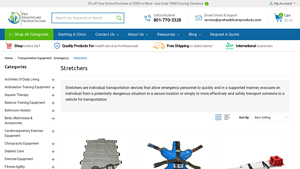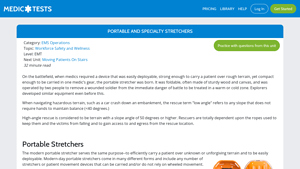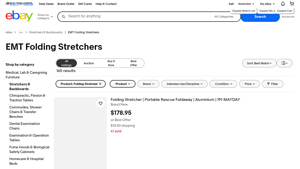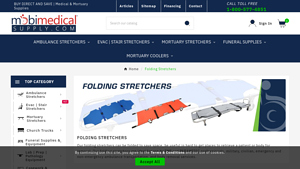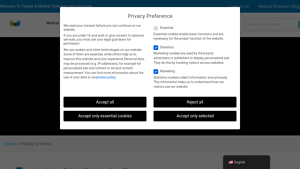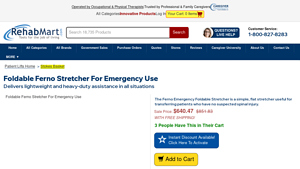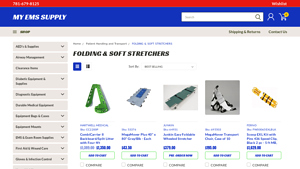Everything You Need to Know About Portable Stretcher Sourcing in 2025
Introduction: Navigating the Global Market for portable stretcher
In an increasingly interconnected world, sourcing reliable portable stretchers poses a significant challenge for B2B buyers, especially in regions such as Africa, South America, the Middle East, and Europe. The need for efficient patient transport solutions is paramount in emergency medical services, disaster response, and remote healthcare settings. This guide serves as a comprehensive resource, providing insights into various types of portable stretchers, their applications, and essential factors to consider when selecting suppliers.
Our aim is to empower international buyers by demystifying the procurement process. From understanding the nuances of different stretcher designs—such as scoop stretchers, flexible stretchers, and basket stretchers—to exploring key considerations like material durability, weight capacity, and portability, this guide addresses all aspects of sourcing. Additionally, we delve into supplier vetting processes, cost analysis, and compliance with international safety standards, ensuring that buyers can make informed decisions that align with their operational needs.
By leveraging the insights and actionable information presented in this guide, B2B buyers can confidently navigate the global market for portable stretchers, ultimately enhancing their capacity to provide safe and effective patient transport solutions in critical situations. Whether you are in Nigeria, Vietnam, or any other region, this guide is designed to meet your unique requirements and support your mission in delivering quality healthcare.
Understanding portable stretcher Types and Variations
| Type Name | Key Distinguishing Features | Primary B2B Applications | Brief Pros & Cons for Buyers |
|---|---|---|---|
| Basket Stretcher | Durable construction, open design for patient visibility | Wilderness rescues, industrial sites | Pros: Versatile in rough terrain; Cons: Bulky for storage. |
| Scoop Stretcher | Adjustable length, allows for easy patient loading without lifting | Emergency medical services, trauma care | Pros: Minimizes patient movement; Cons: Requires trained personnel. |
| Flexible Stretcher | Lightweight, rollable design, multiple handles for lifting | Tight spaces, stair rescues | Pros: Ideal for confined areas; Cons: Limited spinal support. |
| Folding Stretcher | Compact, easily stored, quick setup | Ambulances, emergency response teams | Pros: Space-efficient; Cons: May lack durability for heavy patients. |
| Pediatric Stretcher | Designed specifically for children, often with safety restraints | Pediatric emergency services, hospitals | Pros: Tailored for smaller patients; Cons: Limited weight capacity. |
What Are the Key Characteristics of Basket Stretchers?
Basket stretchers are characterized by their robust design, typically made of metal or durable plastic with a mesh or canvas bottom. They are used primarily in wilderness rescue operations and industrial sites where patients need to be transported over rugged terrain. When considering a basket stretcher, B2B buyers should evaluate the weight capacity, ease of use in various environments, and whether the stretcher can be effectively secured for transport.
How Do Scoop Stretchers Facilitate Patient Transport?
Scoop stretchers are known for their unique design that allows them to be split into two halves, enabling easy placement under an immobile patient without lifting. This type of stretcher is commonly utilized in emergency medical services and trauma care settings. Buyers should consider factors such as the stretcher’s weight limit, portability, and whether it includes safety straps for secure patient transport.
What Advantages Do Flexible Stretchers Offer in Confined Spaces?
Flexible stretchers are designed for maneuverability in tight spaces, making them ideal for stair rescues or narrow hallways. Their lightweight and rollable structure allows for quick deployment and easy handling by emergency responders. When purchasing flexible stretchers, B2B buyers should assess the stretcher’s ability to provide adequate support, the number of handles for lifting, and the training requirements for personnel who will use them.
Why Are Folding Stretchers Popular Among Emergency Response Teams?
Folding stretchers are compact and can be easily stored in ambulances or emergency response vehicles. They offer quick setup times, which is critical in emergency situations. B2B buyers should focus on the stretcher’s durability, load capacity, and how well it can withstand repeated use in high-pressure environments.
What Makes Pediatric Stretchers Essential for Child Patient Care?
Pediatric stretchers are specifically designed to cater to the needs of younger patients, often featuring safety restraints and a smaller frame. They are essential for pediatric emergency services and hospitals. Buyers should evaluate the weight capacity, safety features, and comfort of the stretcher to ensure it meets the specialized needs of child patients.
Key Industrial Applications of portable stretcher
| Industry/Sector | Specific Application of Portable Stretcher | Value/Benefit for the Business | Key Sourcing Considerations for this Application |
|---|---|---|---|
| Emergency Medical Services | Rapid patient transport during emergencies | Ensures timely medical intervention and patient safety | Durability, weight capacity, ease of cleaning, portability |
| Disaster Response and Rescue | Evacuating individuals from disaster-stricken areas | Facilitates safe and efficient evacuation | Resistance to environmental factors, compact design |
| Industrial and Construction | Transporting injured workers from remote locations | Minimizes downtime and enhances workplace safety | Load capacity, stability on uneven terrain, ease of use |
| Military and Tactical Operations | Transporting wounded personnel in combat zones | Quick deployment and mobility in challenging terrains | Lightweight materials, ease of handling, versatility |
| Sports and Recreation | Emergency response in sporting events | Immediate care for injuries, enhancing participant safety | Compliance with safety standards, portability, and comfort |
How is a Portable Stretcher Used in Emergency Medical Services?
In Emergency Medical Services (EMS), portable stretchers play a crucial role in rapidly transporting patients from the scene of an incident to medical facilities. They are designed for quick deployment, ensuring that medical personnel can respond efficiently during emergencies. The need for durability and a high weight capacity is paramount, especially in regions with varying patient demographics. Buyers should consider stretchers that are easy to clean and maintain, as hygiene is critical in medical environments, particularly in countries with limited access to resources.
What Role Does a Portable Stretcher Play in Disaster Response and Rescue?
In disaster-stricken areas, portable stretchers are essential for evacuating individuals safely. They allow rescue teams to transport victims over challenging terrains, including rubble and uneven ground, which is common in regions affected by natural disasters. The ability to withstand harsh environmental conditions is vital, making sourcing materials that are resistant to wear and tear a priority. Compact design is also crucial, enabling easy transport and deployment in emergency situations where time is of the essence.
How Can Portable Stretchers Improve Safety in Industrial and Construction Settings?
In industrial and construction environments, portable stretchers are invaluable for transporting injured workers from remote locations to safety. They help minimize downtime by facilitating quick medical assistance, which is essential for maintaining productivity and compliance with safety regulations. When sourcing, businesses should focus on stretchers that offer stability on uneven terrain, ensuring safe transport in rugged conditions. Additionally, ease of use and the ability to accommodate various load capacities are key considerations to enhance workplace safety.
Why are Portable Stretchers Important for Military and Tactical Operations?
Military and tactical operations require highly mobile and versatile equipment, making portable stretchers indispensable for transporting wounded personnel in combat zones. Their lightweight nature and ease of handling allow medics to quickly evacuate injured soldiers from dangerous situations. Buyers in this sector must prioritize stretchers that can withstand the rigors of combat, such as durable materials and designs that allow for rapid deployment in various terrains. Versatility is also critical, as these stretchers need to adapt to different operational needs.
How Do Portable Stretchers Enhance Safety in Sports and Recreation?
In sporting events, portable stretchers are crucial for providing immediate care to injured athletes. Their quick deployment allows for timely medical intervention, which can prevent further injury and ensure participant safety. Compliance with safety standards is essential when sourcing these products, as well as ensuring they are portable and comfortable for patients. This is particularly important in regions where access to medical facilities may be limited, allowing for a swift response to emergencies on-site.
3 Common User Pain Points for ‘portable stretcher’ & Their Solutions
Scenario 1: Ensuring Patient Safety During Transport
The Problem: B2B buyers often face challenges related to the safety and stability of portable stretchers during patient transport. In regions with diverse terrains, such as the rugged landscapes of Africa or the urban settings of South America, the risk of the stretcher collapsing or failing during use increases, especially when transporting heavier patients. Buyers are concerned about the stretcher’s ability to securely hold patients while navigating uneven surfaces, leading to potential injuries for both patients and medical personnel.
The Solution: To address these concerns, it is crucial to select portable stretchers that are specifically designed for high stability and weight capacity. Buyers should prioritize models that feature reinforced construction with materials like high-strength aluminum or steel, which can withstand heavy loads without compromising safety. Additionally, stretchers equipped with non-skid rubber feet and secure locking mechanisms can enhance stability during transport. When sourcing portable stretchers, conducting thorough evaluations of manufacturer specifications and user reviews can help ensure that the selected model meets rigorous safety standards. Training staff on proper handling techniques will further mitigate risks, ensuring that they are well-prepared to navigate challenging terrains safely.
Scenario 2: Quick Deployment in Emergency Situations
The Problem: In emergency medical services (EMS), time is of the essence. B2B buyers often encounter portable stretchers that are cumbersome and time-consuming to deploy, especially in critical situations where every second counts. The inability to quickly and efficiently set up a stretcher can result in delays in patient care, which can be detrimental in life-threatening scenarios.
The Solution: To ensure rapid deployment, B2B buyers should look for portable stretchers that feature a quick-release folding mechanism and lightweight materials. Models that allow for one-handed operation can significantly reduce setup time. Additionally, investing in stretchers designed for specific emergency contexts, such as scoop stretchers for trauma cases, can enhance efficiency. Buyers should also consider stretchers that come with pre-attached safety straps and easy-to-follow instructions, enabling staff to act swiftly without fumbling. Regular drills and training sessions can help ensure that all personnel are familiar with the operation of the chosen stretchers, allowing them to respond promptly during emergencies.
Scenario 3: Maintenance and Hygiene Challenges
The Problem: Maintaining cleanliness and hygiene in medical transport equipment is a critical concern for B2B buyers, particularly in regions where healthcare resources may be limited. Portable stretchers can become contaminated with bodily fluids or pathogens, leading to potential health risks for both patients and healthcare providers. The challenge lies in sourcing stretchers that are easy to clean and resistant to wear and tear.
The Solution: Buyers should prioritize stretchers made from high-quality, waterproof, and anti-tear materials that can withstand rigorous cleaning protocols. For example, stretchers made from PVC or similar materials can be easily wiped down and disinfected after each use. It is also beneficial to select models with removable, machine-washable covers to facilitate thorough cleaning. Implementing a routine maintenance schedule, including regular inspections for wear and tear, can prolong the lifespan of the stretchers and ensure they remain hygienic. Buyers should also provide training for staff on proper cleaning techniques to reinforce the importance of maintaining a sanitary environment, ultimately enhancing patient safety and care quality.
Strategic Material Selection Guide for portable stretcher
What Are the Key Materials Used in Portable Stretchers?
When selecting materials for portable stretchers, it is crucial to consider their properties, advantages, and limitations. This analysis focuses on four common materials: aluminum, high-density polyethylene (HDPE), PVC, and steel. Each material has unique characteristics that can significantly impact performance and suitability for various applications.
How Does Aluminum Contribute to Portable Stretcher Performance?
Aluminum is a lightweight, corrosion-resistant metal known for its excellent strength-to-weight ratio. It typically has a temperature rating that can withstand extreme conditions, making it suitable for outdoor and emergency use.
Pros: The primary advantage of aluminum is its lightweight nature, which facilitates easier transport and handling. It is also resistant to rust and corrosion, ensuring longevity even in harsh environments.
Cons: However, aluminum can be more expensive than other materials and may not be as durable under heavy loads compared to steel. Additionally, it can be prone to denting and deformation under extreme stress.
Impact on Application: Aluminum stretchers are ideal for emergency medical services (EMS) and rescue operations, where weight and maneuverability are critical.
Considerations for International Buyers: Buyers should ensure compliance with international standards such as ASTM and ISO, particularly in regions like Africa and South America, where environmental conditions can vary significantly.
What Role Does High-Density Polyethylene (HDPE) Play in Portable Stretchers?
High-density polyethylene (HDPE) is a thermoplastic known for its impact resistance and durability. It is often used in the construction of stretchers due to its ability to withstand various temperatures and resist chemicals.
Pros: HDPE is lightweight, resistant to moisture, and easy to clean, making it a hygienic option for medical applications. Its flexibility allows for comfortable patient transport.
Cons: On the downside, HDPE may not offer the same level of structural strength as metals like aluminum or steel, potentially limiting its use for heavier patients.
Impact on Application: HDPE stretchers are particularly effective in environments where hygiene is paramount, such as hospitals and clinics.
Considerations for International Buyers: Compliance with local health regulations and standards, such as DIN or JIS, is essential, especially in regions with stringent medical equipment guidelines.
How Does PVC Enhance the Usability of Portable Stretchers?
Polyvinyl chloride (PVC) is a synthetic plastic polymer commonly used in portable stretchers due to its lightweight and waterproof properties.
Pros: PVC is cost-effective, easy to manufacture, and resistant to moisture and chemicals, making it suitable for various medical environments. Its flexibility also allows for comfortable patient handling.
Cons: However, PVC can be less durable than other materials, especially under high stress or extreme temperatures, which may lead to cracking or tearing.
Impact on Application: PVC stretchers are often used in temporary medical facilities or during events where cost and ease of use are prioritized.
Considerations for International Buyers: Buyers should check for compliance with regional standards and consider the climatic conditions in their area, as PVC may be less effective in extreme heat or cold.
What Are the Advantages and Limitations of Steel in Portable Stretchers?
Steel is a robust material often used in the construction of heavy-duty stretchers. It offers excellent strength and durability, making it suitable for transporting larger patients.
Pros: The primary advantage of steel is its unmatched strength and load-bearing capacity, ensuring safety during transport. Steel stretchers are also resistant to damage from rough handling.
Cons: However, steel is significantly heavier than other materials, which can complicate transport and maneuverability. Additionally, it is prone to rust if not properly coated.
Impact on Application: Steel stretchers are ideal for heavy-duty applications, such as rescue operations in rugged environments.
Considerations for International Buyers: Buyers should ensure that steel stretchers meet international safety standards and are treated to prevent corrosion, especially in humid climates prevalent in regions like the Middle East and parts of Africa.
Summary Table of Material Selection for Portable Stretchers
| Material | Typical Use Case for Portable Stretcher | Key Advantage | Key Disadvantage/Limitation | Relative Cost (Low/Med/High) |
|---|---|---|---|---|
| Aluminum | Emergency medical services, rescue operations | Lightweight and corrosion-resistant | Can dent under stress, higher cost | Medium |
| High-Density Polyethylene (HDPE) | Hospitals, clinics | Impact-resistant and easy to clean | Limited structural strength for heavy loads | Low |
| PVC | Temporary medical facilities, events | Cost-effective and waterproof | Less durable under stress, prone to cracking | Low |
| Steel | Heavy-duty rescue operations | Excellent strength and load capacity | Heavy and prone to rust without treatment | High |
This guide aims to provide B2B buyers with actionable insights into material selection for portable stretchers, ensuring they make informed decisions that align with their operational needs and compliance requirements.
In-depth Look: Manufacturing Processes and Quality Assurance for portable stretcher
What Are the Main Stages in the Manufacturing Process of Portable Stretchers?
The manufacturing process for portable stretchers involves several key stages that ensure the final product meets the stringent requirements of healthcare environments. These stages include material preparation, forming, assembly, and finishing.
-
Material Preparation: The first step involves selecting high-quality materials that are durable, lightweight, and suitable for medical use. Common materials include high-strength aluminum alloys for the frame, waterproof PVC or nylon for the fabric, and heavy-duty rubber for grips. Materials are sourced based on their compliance with international safety standards and their ability to withstand rigorous use.
-
Forming: During the forming stage, raw materials are shaped into the required components. This can involve processes such as cutting, bending, and welding for metal parts, as well as sewing and laminating for fabric components. Advanced techniques like hydroforming or die-casting may also be employed for creating complex shapes that enhance the stretcher’s functionality and ergonomics.
-
Assembly: Once all components are formed, they are assembled into the final product. This stage requires precision to ensure that all parts fit together correctly, allowing for safe and efficient patient transport. Assembly may involve mechanical fastening, welding, or using adhesives, depending on the materials and design specifications.
-
Finishing: The final stage involves applying any necessary coatings or treatments to enhance durability and performance. This may include anti-corrosion coatings for metal parts, UV resistance for fabrics, or waterproofing treatments. The finishing process also includes quality checks to ensure that all components meet the required specifications before packaging.
How is Quality Assurance Implemented in Portable Stretcher Manufacturing?
Quality assurance (QA) is a critical aspect of the manufacturing process for portable stretchers, ensuring that products are safe, reliable, and compliant with international standards.
-
Adherence to International Standards: Many manufacturers follow ISO 9001 standards, which provide a framework for quality management systems. Additionally, products may need to meet specific industry standards such as CE marking in Europe or FDA regulations in the United States. Compliance with these standards demonstrates a commitment to quality and safety.
-
Quality Control Checkpoints: The QA process typically includes several checkpoints:
– Incoming Quality Control (IQC): This initial stage involves inspecting raw materials for quality before they enter the production process. This ensures that only materials that meet predefined standards are used in manufacturing.
– In-Process Quality Control (IPQC): Throughout the manufacturing process, regular inspections are conducted to ensure that each stage meets quality standards. This could involve checking dimensions, tolerances, and other critical specifications.
– Final Quality Control (FQC): After assembly, a comprehensive inspection is performed on the finished product to ensure it meets all design and safety requirements. This may include load testing, functionality tests, and visual inspections for defects. -
Common Testing Methods for Portable Stretchers: Various testing methods are used to ensure that stretchers can withstand the rigors of medical transport. These include:
– Load Testing: Stretchers are subjected to weight loads that exceed their specified limits to verify structural integrity.
– Durability Testing: This involves simulating real-world conditions to assess how well the stretcher performs over time.
– Safety Testing: Evaluating features such as locking mechanisms, handles, and strapping systems to ensure they function correctly and safely under stress.
How Can B2B Buyers Verify Supplier Quality Control Processes?
For B2B buyers, especially in international markets such as Africa, South America, the Middle East, and Europe, verifying a supplier’s quality control processes is crucial to ensuring product safety and reliability.
-
Supplier Audits: Conducting on-site audits of potential suppliers can provide valuable insights into their manufacturing processes and quality control practices. During these audits, buyers can evaluate compliance with international standards, inspect quality control systems, and review records of past inspections and testing.
-
Quality Control Reports: Requesting detailed quality control reports from suppliers can help buyers understand the measures taken to ensure product quality. These reports should include information on testing methods, results, and any corrective actions taken in response to quality issues.
-
Third-Party Inspections: Engaging third-party inspection services can provide an unbiased evaluation of a supplier’s products and processes. These inspections can include pre-shipment inspections, factory audits, and product testing to ensure compliance with specified standards.
What Are the Quality Control and Certification Nuances for International Buyers?
When dealing with international suppliers, buyers must be aware of specific quality control and certification nuances that may affect their purchasing decisions.
-
Regulatory Compliance: Different regions have varying regulations regarding medical devices, including stretchers. Buyers should familiarize themselves with the regulations in their target markets, such as the Medical Device Regulation (MDR) in Europe or the relevant health regulations in Africa and South America.
-
Certification Requirements: Products may need specific certifications to be legally marketed in different countries. For example, CE marking is essential for medical devices sold in the European market, while FDA approval is required in the U.S. Buyers should ensure that suppliers hold the necessary certifications for their products to avoid legal issues.
-
Cultural and Language Barriers: International buyers may encounter language barriers and cultural differences that can affect communication regarding quality expectations. Establishing clear communication channels and agreements can mitigate these challenges and ensure that quality expectations are understood and met.
In conclusion, a thorough understanding of the manufacturing processes and quality assurance practices for portable stretchers is essential for B2B buyers in the healthcare industry. By focusing on these aspects, buyers can make informed decisions that prioritize safety, reliability, and compliance with international standards.
Practical Sourcing Guide: A Step-by-Step Checklist for ‘portable stretcher’
Introduction
This guide aims to provide B2B buyers with a structured approach to sourcing portable stretchers, essential for effective patient transport in various medical and emergency scenarios. Understanding the intricacies of portable stretcher procurement can lead to better decision-making, ensuring that you select high-quality, reliable equipment that meets your operational needs.
Step 1: Define Your Technical Specifications
Before initiating the procurement process, clearly outline the technical specifications required for your portable stretcher. Consider factors such as weight capacity, material durability, and specific features like foldability or waterproof capabilities. This step is critical to ensure the stretcher meets the operational demands of your medical services.
Step 2: Identify the Intended Use Cases
Understanding the specific environments and scenarios in which the stretcher will be used is vital. Will it be utilized in urban settings, rugged terrain, or during air evacuations? Different use cases may require specialized stretchers, such as scoop stretchers for immobilization or flexible stretchers for tight spaces. Tailoring your search to these needs will enhance the effectiveness of your equipment.
Step 3: Evaluate Potential Suppliers
Conduct a thorough evaluation of potential suppliers to ensure they meet your requirements. Look for suppliers with a proven track record in the industry, positive customer reviews, and relevant certifications. Request case studies or references from similar organizations to validate their capabilities and reliability.
Step 4: Verify Compliance with International Standards
Ensure that the portable stretchers you consider comply with relevant international safety and quality standards. Compliance with certifications such as ISO or CE is essential for ensuring product safety and efficacy. This not only protects patients but also aligns with regulatory requirements in your region.
Step 5: Assess Product Features and Benefits
Examine the specific features offered by different stretcher models. Look for essential attributes such as:
– Weight and Portability: Lightweight designs facilitate easier transport and storage.
– Safety Features: Non-skid grips and secure fastening mechanisms enhance patient safety during transport.
– Ease of Cleaning: Materials should be easy to disinfect, promoting hygiene in patient care.
Step 6: Request Samples for Testing
Before finalizing your purchase, request samples of the stretchers for testing in real-world scenarios. This hands-on evaluation allows you to assess their performance, durability, and ease of use in the field. Engaging your medical personnel in this process can provide valuable insights into the suitability of the equipment.
Step 7: Negotiate Terms and Conditions
Once you have selected a supplier and product, negotiate the terms of purchase, including pricing, delivery timelines, and warranty options. Establishing clear terms will help prevent misunderstandings and ensure that you receive the necessary support for your portable stretcher procurement.
By following this checklist, B2B buyers can streamline their sourcing process for portable stretchers, ensuring that they select the best equipment for their operational needs while maintaining high standards of patient care.
Comprehensive Cost and Pricing Analysis for portable stretcher Sourcing
What Are the Key Cost Components in Portable Stretcher Manufacturing?
When sourcing portable stretchers, understanding the cost structure is essential for B2B buyers. The primary cost components include:
-
Materials: The choice of materials directly influences the stretcher’s quality and price. Common materials include high-quality PVC, aluminum, and reinforced fabrics. Each material varies in durability, weight, and cost, affecting the overall pricing.
-
Labor: Labor costs encompass the wages of workers involved in manufacturing and assembly. Regions with lower labor costs may offer competitive pricing, but it’s crucial to balance cost with quality.
-
Manufacturing Overhead: This includes indirect costs such as utilities, rent, and equipment depreciation. Efficient production processes can help minimize these overhead costs, leading to more competitive pricing.
-
Tooling: Initial tooling costs for molds and specialized equipment can be substantial, especially for custom or specialized stretchers. These costs are typically amortized over the production volume.
-
Quality Control (QC): Stringent QC measures ensure that stretchers meet safety and performance standards. Investing in robust QC processes can increase initial costs but may reduce long-term liabilities associated with product failures.
-
Logistics: Transportation and handling costs impact the final price. Factors such as shipping distance, method, and import tariffs can significantly affect logistics costs.
-
Margin: Suppliers will add a profit margin to cover their operational costs and generate profit. This margin can vary based on market conditions and competition.
How Do Price Influencers Affect Portable Stretcher Sourcing?
Several factors influence the pricing of portable stretchers:
-
Volume/MOQ (Minimum Order Quantity): Higher order volumes typically lead to lower per-unit costs due to economies of scale. Buyers should consider their needs carefully to negotiate favorable terms.
-
Specifications and Customization: Custom features, such as specific sizes or additional safety features, can increase costs. Buyers should assess whether these enhancements are essential for their operations.
-
Material Quality and Certifications: Stretchers that meet international safety standards or certifications (e.g., ISO) may come at a premium. Investing in certified products can enhance safety and reliability.
-
Supplier Factors: The supplier’s reputation, reliability, and production capabilities can influence pricing. Established suppliers with a track record of quality may charge higher prices but offer peace of mind.
-
Incoterms: Understanding the Incoterms (International Commercial Terms) can help buyers manage costs effectively. Terms like FOB (Free on Board) or CIF (Cost, Insurance, and Freight) dictate who is responsible for shipping and insurance, affecting overall costs.
What Are the Best Practices for Negotiating Portable Stretcher Prices?
B2B buyers can adopt several strategies to enhance cost-efficiency when sourcing portable stretchers:
-
Negotiate Terms: Engage suppliers in discussions about pricing, payment terms, and delivery schedules. Building a good relationship can lead to better deals.
-
Evaluate Total Cost of Ownership (TCO): Consider not just the purchase price but also maintenance, durability, and potential resale value. A slightly higher upfront cost may lead to lower long-term expenses.
-
Research Market Prices: Understanding the market landscape helps buyers gauge fair pricing and negotiate effectively. Utilize industry reports and competitor pricing as benchmarks.
-
Consider Local Suppliers: Sourcing from local manufacturers may reduce logistics costs and lead times, particularly for urgent needs.
-
Be Mindful of International Pricing Nuances: For buyers from regions like Africa, South America, the Middle East, and Europe, factors such as currency fluctuations, import duties, and local regulations can impact pricing. Staying informed about these variables is crucial for budgeting.
Conclusion
In conclusion, a comprehensive understanding of the cost structure and pricing influences for portable stretchers is critical for B2B buyers. By carefully evaluating these components and employing effective negotiation strategies, buyers can secure quality products at competitive prices, ensuring they meet their operational needs while maintaining financial efficiency. Always remember that prices are indicative and may vary based on market conditions and supplier negotiations.
Alternatives Analysis: Comparing portable stretcher With Other Solutions
Understanding Alternatives in Patient Transport Solutions
In the realm of emergency medical services (EMS) and patient transport, it is crucial to evaluate various solutions to ensure optimal care and efficiency. While portable stretchers are widely recognized for their versatility and ease of use, alternative methods and technologies may offer specific advantages depending on the situation. This analysis provides a comparative overview of portable stretchers against other viable solutions, such as flexible stretchers and scoop stretchers.
Comparison Table
| Comparison Aspect | Portable Stretcher | Flexible Stretcher | Scoop Stretcher |
|---|---|---|---|
| Performance | High; suitable for varied terrains and conditions | Moderate; limited spinal immobilization capability | High; allows for safe patient transfer without lifting |
| Cost | Moderate; typically ranges from $100 to $300 | Low to moderate; usually between $50 and $200 | Moderate; generally priced around $200 to $300 |
| Ease of Implementation | Easy; requires minimal training for operation | Moderate; requires trained personnel for proper use | Easy; straightforward operation with minimal training |
| Maintenance | Low; durable materials require minimal upkeep | Low; typically made from robust materials | Low; simple cleaning and maintenance |
| Best Use Case | General emergency situations, diverse environments | Tight spaces or difficult access areas | Patients with suspected spinal injuries needing careful handling |
Pros and Cons of Alternatives
Flexible Stretcher
Flexible stretchers are designed for maneuverability in confined spaces, making them ideal for emergency situations in urban environments or tight quarters. They consist of a series of rigid rods within a flexible sheet, allowing for patient transport without the need for extensive lifting. However, their ability to provide spinal immobilization is limited compared to other devices, making them less suitable for patients with severe spinal injuries. While they are cost-effective, proper training is essential to ensure safe and effective use, which can add to the overall implementation time.
Scoop Stretcher
Scoop stretchers excel in situations where patients cannot be lifted, such as those with suspected fractures or spinal injuries. Their design allows rescuers to “scoop” the patient without significant movement, minimizing discomfort and risk of further injury. This type of stretcher is particularly effective in emergency medical situations where time and safety are critical. While they are more expensive than flexible stretchers, they offer a level of safety and comfort that is often worth the investment. However, they require trained personnel for optimal use, which may be a consideration for organizations with limited resources.
Choosing the Right Solution for Your Needs
When selecting the appropriate patient transport solution, B2B buyers must carefully consider their specific operational requirements and the environments in which they operate. Portable stretchers are versatile and suitable for a wide range of situations, making them a solid choice for general use. In contrast, flexible and scoop stretchers serve specialized purposes that may be better suited for particular scenarios, such as tight spaces or patients with suspected spinal injuries. Evaluating factors such as cost, ease of use, and performance can help buyers make informed decisions that align with their operational needs and enhance patient care outcomes.
Essential Technical Properties and Trade Terminology for portable stretcher
What Are the Key Technical Properties of Portable Stretchers?
When evaluating portable stretchers for medical or rescue operations, understanding the essential technical properties is crucial for ensuring optimal performance and safety. Here are several critical specifications to consider:
-
Material Composition
– Portable stretchers are typically constructed from high-quality materials such as PVC, aluminum, or reinforced fabric. PVC is favored for its waterproof and anti-tear properties, while aluminum offers lightweight durability. The choice of material directly impacts the stretcher’s weight, load capacity, and ease of cleaning, which are vital for maintaining hygiene in medical settings. -
Weight Capacity
– This specification refers to the maximum weight a stretcher can safely support during patient transport. Most portable stretchers have a weight capacity ranging from 150 kg to 250 kg. Understanding weight limits is crucial for B2B buyers, as it affects the stretcher’s suitability for various patient demographics, ensuring safety during emergency operations. -
Foldability and Portability
– The ability to fold away compactly is a significant property, enabling easy storage and transport. Many modern stretchers feature a folding design that allows them to be quickly deployed and retracted. This is particularly important for emergency responders who require rapid access to equipment in high-pressure situations. -
Stability Features
– Stability is essential when transporting patients, especially on uneven terrain. Many stretchers come equipped with non-skid feet and secure locking mechanisms to prevent movement during transit. Buyers should prioritize stability features to ensure patient safety and comfort during transport. -
Restraint Systems
– Integrated restraint systems, including adjustable straps and safety harnesses, are vital for securing the patient during movement. This specification is particularly important in preventing further injury and ensuring the patient’s safety, making it a key consideration for buyers in emergency medical services. -
Size and Dimensions
– The dimensions of the stretcher must align with the needs of the operation it is intended for. Standard sizes accommodate most adult patients, but specialized stretchers are available for pediatric use or for tight quarters. Understanding size requirements helps ensure that the stretcher will fit in the intended transport vehicles and environments.
What Are Common Trade Terminology and Jargon Related to Portable Stretchers?
Familiarity with industry terminology is essential for effective communication between buyers and suppliers. Here are some common terms related to portable stretchers:
-
OEM (Original Equipment Manufacturer)
– This term refers to companies that produce parts and equipment that may be marketed by another manufacturer. In the stretcher industry, OEMs provide the underlying technology and materials that define product quality and reliability. Buyers should look for OEM certifications to ensure they are purchasing high-quality products. -
MOQ (Minimum Order Quantity)
– MOQ is the smallest number of units that a supplier is willing to sell. Understanding MOQ is crucial for buyers, especially in international markets, as it can impact inventory management and budget planning. -
RFQ (Request for Quotation)
– An RFQ is a formal request sent to suppliers to provide pricing and terms for specific products. B2B buyers should issue RFQs to multiple vendors to compare offers and negotiate better deals, ensuring they get the best value for their investment. -
Incoterms (International Commercial Terms)
– These are internationally recognized rules that define the responsibilities of buyers and sellers in international transactions. Familiarity with Incoterms helps buyers understand shipping responsibilities, costs, and risks associated with the purchase of portable stretchers. -
Lead Time
– This refers to the time taken from placing an order until the product is delivered. Knowing the lead time is essential for planning and ensuring that stretchers are available when needed, particularly in emergency medical scenarios. -
Warranty and Return Policy
– Understanding the warranty and return policy of a stretcher is vital for B2B buyers. A robust warranty ensures that the investment is protected against manufacturing defects, while a clear return policy provides assurance in case the product does not meet expectations.
By grasping these essential technical properties and industry terminologies, B2B buyers can make informed decisions when sourcing portable stretchers for their operations, ensuring both efficacy and safety in patient transport.
Navigating Market Dynamics and Sourcing Trends in the portable stretcher Sector
What are the Current Market Dynamics and Key Trends Influencing the Portable Stretcher Sector?
The global portable stretcher market is witnessing significant growth, driven by a range of factors including the increasing demand for efficient emergency medical services, advancements in medical technology, and the rising prevalence of chronic diseases. In regions like Africa and South America, the expansion of healthcare infrastructure and increased investment in emergency response capabilities are pivotal. Countries such as Nigeria and Vietnam are focusing on enhancing their medical logistics, which includes sourcing high-quality portable stretchers that can be easily deployed in emergencies.
Emerging B2B trends are also shaping the market. The rise of digital platforms for sourcing medical equipment allows international buyers to access a wider range of products and suppliers, facilitating competitive pricing and quicker procurement processes. Moreover, there is a growing emphasis on products that offer versatility—such as foldable and lightweight designs that can withstand challenging terrains—catering to both urban and rural healthcare settings. Additionally, the integration of smart technologies in portable stretchers, such as built-in monitoring systems for vital signs, is becoming more common, appealing to buyers seeking innovative solutions for patient transport.
How is Sustainability and Ethical Sourcing Impacting the Portable Stretcher Market?
Sustainability is increasingly becoming a priority for B2B buyers in the portable stretcher market. The environmental impact of manufacturing processes, particularly in developing regions, has prompted companies to seek out suppliers who adhere to sustainable practices. Buyers are now more inclined to partner with manufacturers that utilize eco-friendly materials and processes, ensuring that their sourcing choices align with global sustainability goals.
Ethical sourcing is critical, especially in regions where supply chain transparency may be lacking. Buyers are looking for manufacturers who can demonstrate compliance with ethical labor practices and sustainable material sourcing. Certifications such as ISO 14001 for environmental management and Oeko-Tex for textile safety are becoming essential for suppliers to prove their commitment to sustainability. By prioritizing these certifications, B2B buyers not only enhance their brand reputation but also contribute to a positive environmental and social impact.
How Has the Portable Stretcher Evolved Over Time?
The evolution of portable stretchers can be traced back to their military origins, where they were designed to safely transport injured soldiers from the battlefield. Early models were simple, made from wood and canvas, and operated by multiple personnel. Over the years, advancements in materials and design have transformed portable stretchers into sophisticated medical devices. Modern stretchers now incorporate lightweight, durable materials such as high-strength PVC, which enhances portability and ease of use.
Today’s portable stretchers are engineered to cater to a variety of emergency scenarios, from urban rescues to challenging wilderness environments. Innovations such as foldable designs and specialized features like scoop mechanisms for spinal immobilization have greatly improved patient safety and comfort. As the market continues to grow, the focus on multifunctional and user-friendly designs remains a key driver, ensuring that portable stretchers meet the dynamic needs of healthcare providers across diverse regions.
Frequently Asked Questions (FAQs) for B2B Buyers of portable stretcher
-
How do I choose the right portable stretcher for my needs?
Selecting the appropriate portable stretcher depends on the specific requirements of your medical services. Consider factors such as the type of emergency situations you will encounter, the terrain where the stretcher will be used, and the weight capacity needed for your patients. For instance, if you anticipate using the stretcher in rugged environments, look for models like basket stretchers designed for rough terrain. Additionally, assess the ease of transport and storage, as well as any special features like waterproof materials or foldability that enhance usability. -
What features should I look for in a high-quality portable stretcher?
Key features to prioritize in a high-quality portable stretcher include durability, weight capacity, and ease of use. Look for stretchers made from robust materials like high-quality PVC or aluminum that can withstand rigorous use. Features such as adjustable lengths, non-skid rubber feet, and secure fastening straps are essential for patient safety. Furthermore, ensure that the stretcher is lightweight and foldable for convenient storage and transport, especially for organizations with limited space in ambulances or emergency response units. -
What is the typical lead time for ordering portable stretchers from suppliers?
Lead times for portable stretchers can vary significantly based on supplier location, manufacturing capabilities, and order size. Generally, expect a lead time of 4 to 8 weeks for standard orders. However, if you are requesting customizations or larger quantities, this timeframe may increase. It’s advisable to communicate directly with potential suppliers to establish clear timelines and confirm availability, ensuring that you can meet your operational needs without delays. -
How can I ensure the quality of portable stretchers before purchase?
To ensure the quality of portable stretchers, conduct thorough supplier vetting. Request product samples and review certifications that demonstrate compliance with international safety standards. Additionally, seek references or testimonials from other B2B buyers who have previously purchased from the supplier. Quality assurance processes, such as inspections during production and before shipment, should also be discussed with the supplier to guarantee that the stretchers meet your specifications and safety requirements. -
What are the minimum order quantities (MOQ) for portable stretchers?
Minimum order quantities (MOQ) for portable stretchers can vary widely among suppliers. While some may allow orders of just a few units, others may require larger quantities, particularly for custom products. When negotiating with suppliers, inquire about their MOQ policies and any potential for flexibility based on your specific needs. Understanding these terms upfront can help you plan your procurement strategy and manage your budget effectively. -
What payment terms should I expect when sourcing portable stretchers internationally?
Payment terms for international purchases can differ based on supplier policies and the nature of the transaction. Common terms include a deposit (often 30-50%) paid upfront, with the balance due prior to shipment. Some suppliers may offer letters of credit or payment through escrow services for added security. Ensure to clarify payment methods accepted, currency options, and any additional fees associated with international transactions to avoid surprises. -
How do I handle logistics and shipping for portable stretchers?
Handling logistics and shipping for portable stretchers involves coordinating with your supplier and a reliable freight forwarder. Discuss shipping options, including air or sea freight, based on your urgency and budget. Ensure that the supplier provides the necessary documentation for customs clearance, such as commercial invoices and packing lists. It is also wise to understand the delivery timelines and any potential duties or tariffs that may apply upon importation to your country. -
Can portable stretchers be customized for specific medical needs?
Yes, many suppliers offer customization options for portable stretchers to suit specific medical requirements. Customizations can include alterations in size, weight capacity, color, and additional safety features like reinforced handles or specialized straps. When exploring suppliers, inquire about their capabilities for customization and any associated costs or lead time implications. Tailoring a stretcher to your needs can enhance functionality and ensure it meets the unique challenges faced in your operational environment.
Important Disclaimer & Terms of Use
⚠️ Important Disclaimer
The information provided in this guide, including content regarding manufacturers, technical specifications, and market analysis, is for informational and educational purposes only. It does not constitute professional procurement advice, financial advice, or legal advice.
While we have made every effort to ensure the accuracy and timeliness of the information, we are not responsible for any errors, omissions, or outdated information. Market conditions, company details, and technical standards are subject to change.
B2B buyers must conduct their own independent and thorough due diligence before making any purchasing decisions. This includes contacting suppliers directly, verifying certifications, requesting samples, and seeking professional consultation. The risk of relying on any information in this guide is borne solely by the reader.
Top 9 Portable Stretcher Manufacturers & Suppliers List
1. LINE2Design – Deluxe Pedi Save & Pediatric Child Restraint Seat System
Domain: line2ems.com
Registered: 2016 (9 years)
Introduction: Product Types: Extrication (2), Head Immobilization (1), Patient Handling (2), Spineboard/Backboards (1), Stretchers (5)\nAvailability: In stock (11), Out of stock (0)\nKey Products: \n1. LINE2Design Deluxe Pedi Save & Pediatric Child Restraint Seat System – Royal Blue, SKU: 68187-RB, Price: $139.99\n2. LINE2design Spine Board Head Immobilizer for Backboard – Universal EMS EMT Emergency Medical, S…
2. Pro Healthcare Products – Emergency Stretchers
Domain: prohealthcareproducts.com
Registered: 2009 (16 years)
Introduction: This company, Pro Healthcare Products – Emergency Stretchers, is a notable entity in the market. For specific product details, it is recommended to visit their website directly.
3. Medictests – Portable & Specialty Stretchers
Domain: medictests.com
Registered: 2010 (15 years)
Introduction: Portable & Specialty Stretchers for EMS Operations include various types designed for specific situations:
1. **Basket Stretchers**: Used in wilderness rescues, allows for patient transport over steep terrain.
2. **Flexible Stretchers**: Ideal for tight quarters, consists of rigid rods embedded in a sturdy material, allowing for maneuverability and multiple lifting points.
– **Contraindicati…
4. Stryker – EMT Folding Stretcher
Domain: ebay.com
Registered: 1995 (30 years)
Introduction: EMT Folding Stretchers for sale on eBay include various types such as Folding Stretcher, Ambulance Stretcher, Backboard/Spine Board, Basket Stretcher, Scoop Stretcher, and Stair Chair. Brands available include Stryker, Ferno, LINE2design, Iron Duck, North American Healthcare, and Reeves. Intended uses cover a wide range of medical disciplines including Anesthesiology, Emergency Medicine, Orthopedi…
5. Medical Stretchers – 1A1 Aluminum Folding Stretcher
Domain: medical-stretchers.com
Registered: 2011 (14 years)
Introduction: [{‘name’: ‘1A1 Aluminum Folding Stretcher’, ‘price’: ‘$204.95’, ‘features’: [‘Compact size’, ‘Light and robust’, ‘Can be used in hospital, as ambulance stretcher or on battle fields, gymnasium’, ‘FDA, CE and ISO 9001 Certificate’, ‘Maximum load capacity: 350 Lbs’]}, {‘name’: ‘1N Aluminum Folding Stretcher’, ‘price’: ‘$290.00’, ‘features’: [‘Light and robust’, ‘Compact size for limited storage spac…
6. Tingeer – Folding Stretcher
Domain: tingeerstretchers.com
Registered: 2023 (2 years)
Introduction: Folding Stretcher by Tingeer is designed for rescue and emergency medical use. Key features include:
– Lightweight and durable construction, suitable for search and rescue missions, disaster response, and hospital use.
– Quick setup and takedown with a fold-and-go mechanism.
– Made from high-quality aluminum alloy and waterproof fabric, capable of withstanding tough environments and heavy usage.
-…
7. Ferno – Foldable Stretcher for Emergency Use
Domain: rehabmart.com
Registered: 1999 (26 years)
Introduction: Product Name: Foldable Ferno Stretcher For Emergency Use
Sale Price: $640.47 (originally $851.83)
Shipping: Free Shipping
Weight: 8 pounds
Load Limit: 350 pounds
Dimensions: Width – 18 inches, Height – 1 inches, Length – 74 inches, Folded Length – 37 inches
Material: Lightweight aluminum frame, heavy-duty vinyl-coated nylon cover
Key Features: Compact storage due to exclusive slimline center hinge…
8. Ferno – Stretcher Oxygen Straps
Domain: reddit.com
Registered: 2005 (20 years)
Introduction: This company, Ferno – Stretcher Oxygen Straps, is a notable entity in the market. For specific product details, it is recommended to visit their website directly.
9. My EMS Supply – MegaMover Plus Portable Transport Unit
Domain: myemssupply.com
Registered: 2011 (14 years)
Introduction: This company, My EMS Supply – MegaMover Plus Portable Transport Unit, is a notable entity in the market. For specific product details, it is recommended to visit their website directly.
Strategic Sourcing Conclusion and Outlook for portable stretcher
What Are the Key Takeaways for Strategic Sourcing of Portable Stretchers?
In the dynamic landscape of emergency medical services, strategic sourcing of portable stretchers is paramount. Buyers must prioritize quality, durability, and versatility to ensure their equipment meets the diverse needs of various environments—whether in urban settings or challenging terrains. Understanding product specifications, such as weight capacity and materials used, can guide procurement decisions that enhance patient safety and responder efficiency.
How Can International Buyers Benefit from Strategic Sourcing?
For international B2B buyers, especially in regions like Africa, South America, the Middle East, and Europe, leveraging strategic sourcing can lead to significant cost savings and improved supply chain resilience. By forming partnerships with reputable manufacturers that emphasize innovation and reliability, organizations can secure the best products tailored to their specific operational requirements.
What’s Next for Your Organization?
As you explore options for portable stretchers, consider engaging with suppliers who offer comprehensive support, including training on equipment usage. This proactive approach not only strengthens your operational capacity but also ensures that your team is well-prepared for any emergency. Embrace the future of patient transport by investing in quality portable stretchers that align with your mission to provide effective and compassionate care. Your commitment to sourcing wisely today will empower your organization to respond effectively to the challenges of tomorrow.
